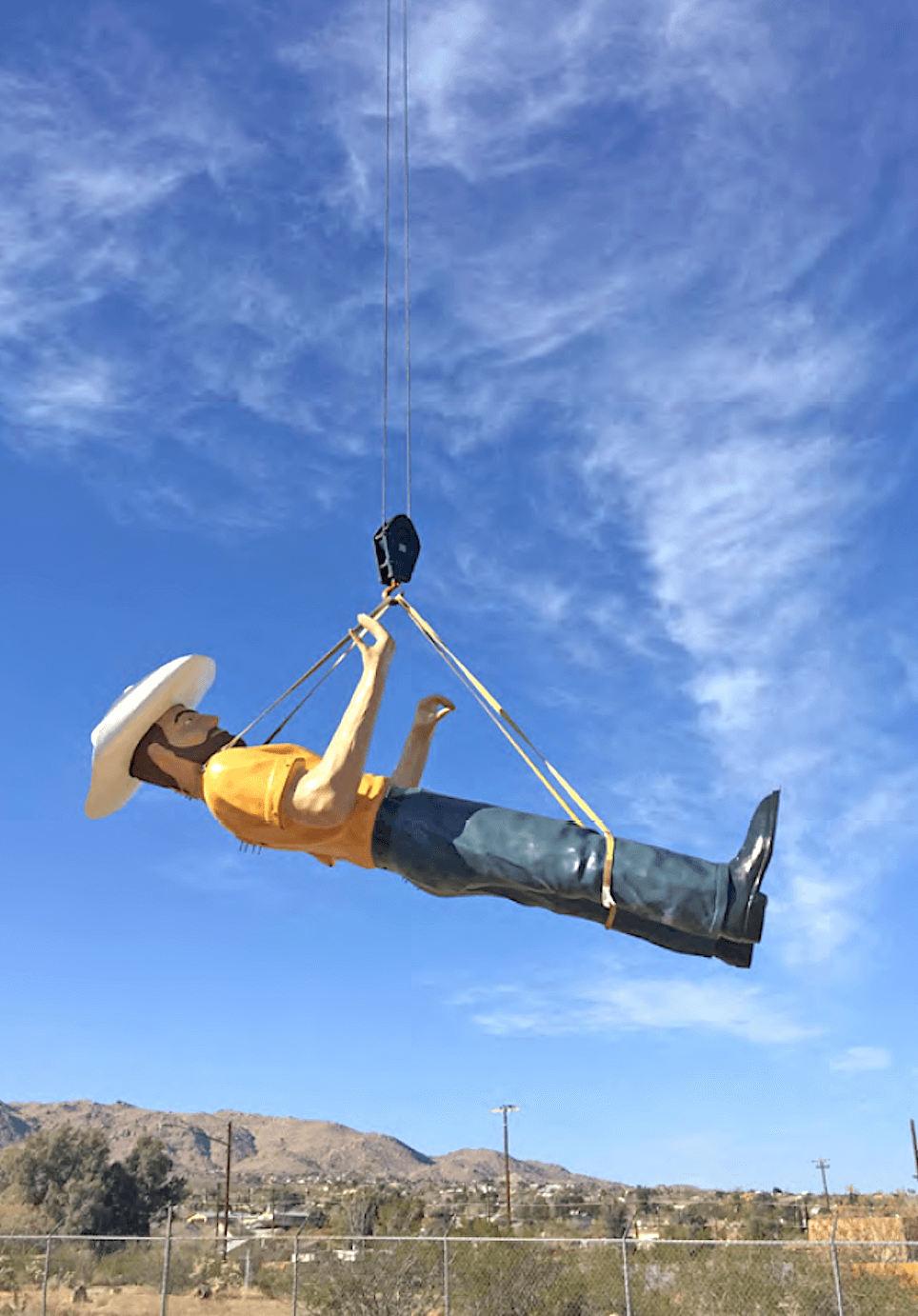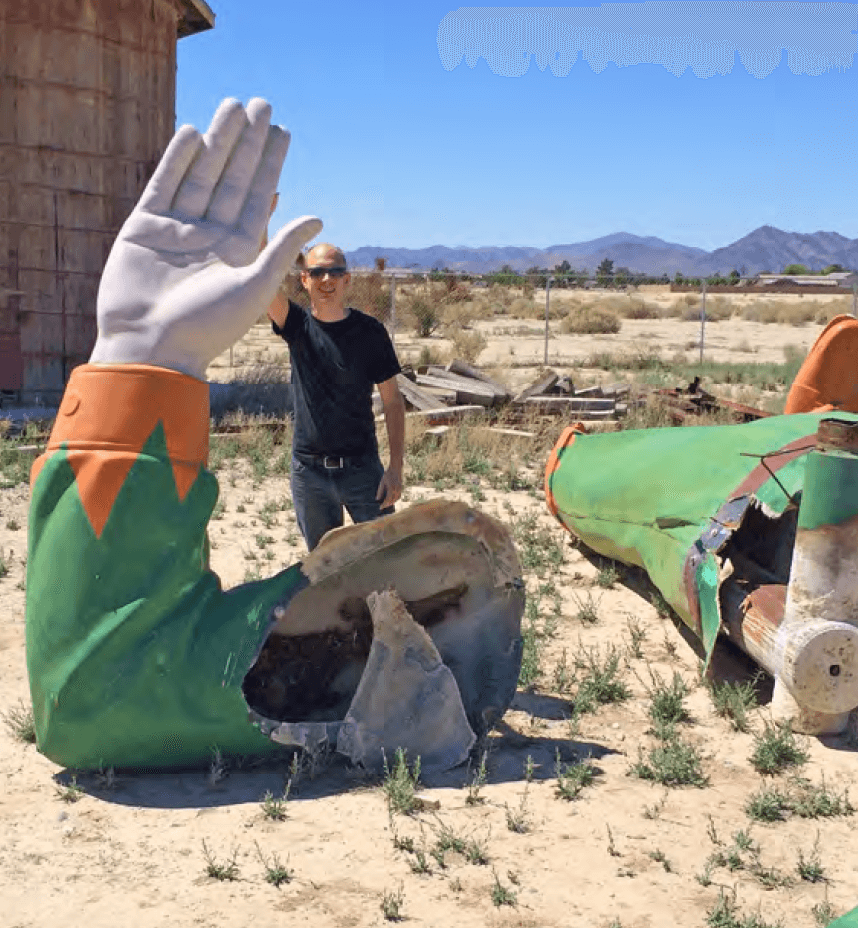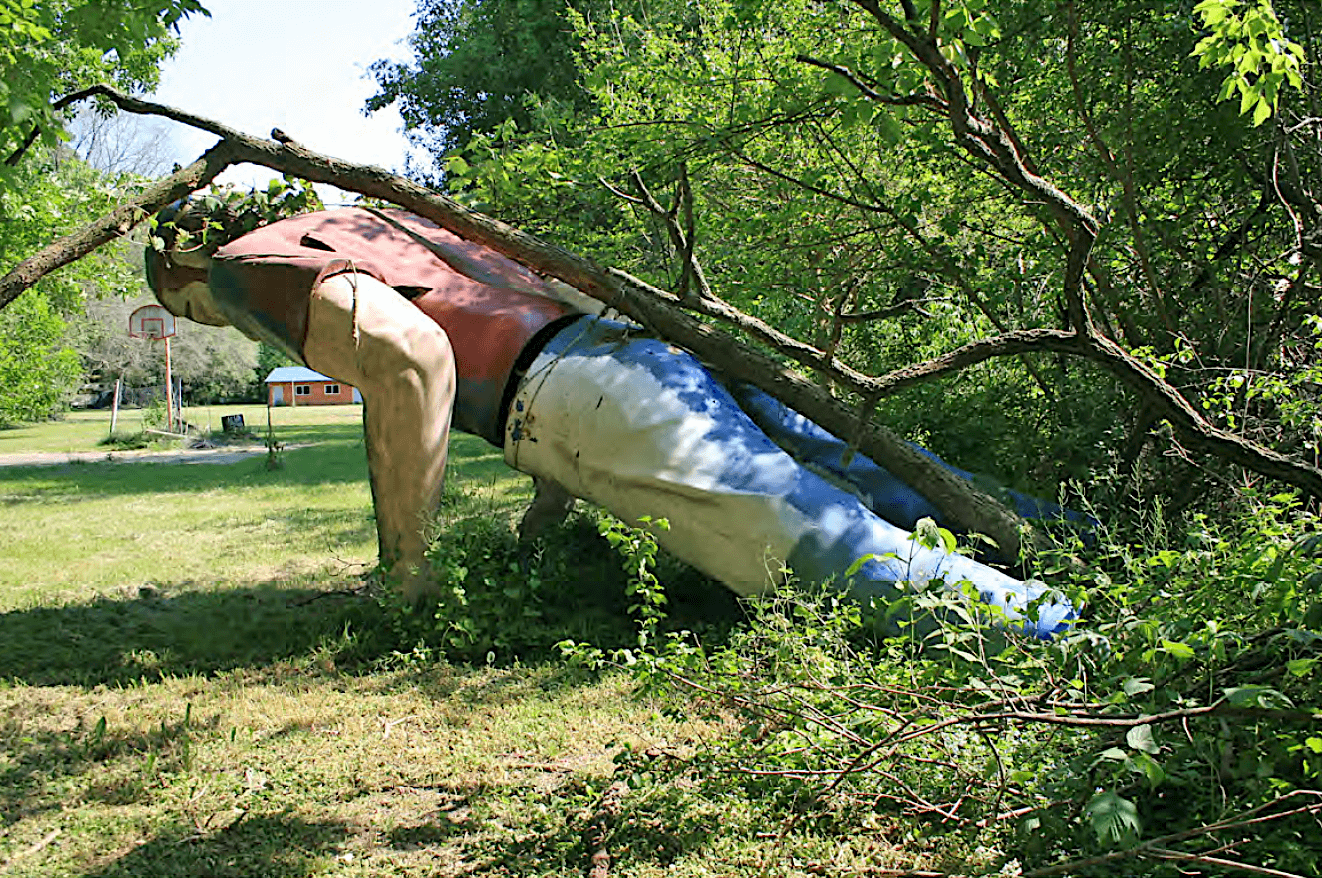As the 1950s turned into the 1960s, though, a new, louder, different voice was needed, because it seemed that everyone had mounted a roadside sign to try to divert traffic. While modern day sign geeks love chasing neon and the remnants of a bygone era, those signs became banal and common enough that International Fiberglass saw an opportunity to take outdoor marketing to a new level, one that stood 20-feet tall, and would cause people not only to pay attention, but also to pull over for a photograph. You just didn’t have that happening with neon signs back then.
For about a decade, American streets and highways became populated with hundreds of roadside giants that we know collectively today as Muffler Men, if only because of the figures produced for a muffler chain. Many have disappeared, but nostalgia being what it is, there is movement afoot today not only to restore and preserve the figures remaining, but also to craft new ones.
Out of the Mold
“The origins of these giants started with a guy named Bob Prewitt. He was trying to sell fiberglass trailers and made an awful looking papier-mâché horse to stand in it,” said Joel Baker, founder of American Giants. Prewitt soon made contact with a sculptor, who designed a more realistic model and hit paydirt. “In January 1961, he took it to the Denver Fat Stock Show, and got 16 orders for the horse and two for the trailer.”
And an era was born.
“Later that same year he got an order from a businessman in Sacramento for a 20-foot Paul Bunyan, and so the first ‘Muffler Man’ was built,” Baker continued. A fiberglass mold was made from the original sculpture in case copies would ever be desired. The deal fell through for unknown reasons, though, and Prewitt hit the road to look for a customer. He found it on Route 66 at the Paul Bunyan Cafe in Flagstaff, Arizona. It was a match made in fiberglass heaven. Louie the Lumberjack was an instant hit. When they changed their name to the Lumberjack Café, they purchased a second statue.

Fiberglass, which has been used as insulation for years, found its stride in 1953 with the first Corvette containing fiberglass reinforced plastic body parts. From there, builders realized that it could be used for practically anything, which prompted Prewitt to build his horse trailers. While Prewitt wasn’t the first to build fiberglass animals, he is the one remembered for running with the idea, even if it wasn’t all that intentional.
“The Paul Bunyan statue was just an extra for someone who wanted one. Then everyone had to have one,” Baker laughed. What started as a one-off wound up launching a nationwide craze.
Prewitt had hardly started down this new path when he sold most of his molds to Stanley Dashew, an inventor and businessman. Dashew established International Fiberglass for his son, Steve, to run as a way to offset the slow season in their primary product line, fiberglass boats. However, the 20-foot Bunyan was an instant success.
In short order, “Steve had a few versions of the statue made, like a cowboy, Indian, and the Mortimer Snerd,” continued Baker.
The Snerd was also known as a “half-wit,” and looked strikingly similar to Mad Magazine’s Alfred E. Neuman. Most statues were 20-feet tall, although there were also 14-foot variations. While most had the trademark hands, one cupped, the other reversed, the vast majority never held mufflers or, as originally released, axes. The generic “Muffler Man” name stuck, though.
A tipping point was reached in months. “Steve started marketing and before long he had contracts with major oil giants who were all interested in having a huge statue at their filling station,” Baker added. The result was the Texaco Big Friend, Phillips 66 Cowboy, and Uniroyal Girl, all made possible by making minor variations in the original mold.
“The year 1965 saw dozens of these giants being shipped out along with many other famous figures that we still see and collect today, like the A&W Root Beer Family, Sinclair Dinos, and Bob’s Big Boy.”
Marketing Genius

Mark Cline, of Enchanted Castle Studios in Waynesboro, Virginia, recognizes the marketing value of Muffler Men and their variants, and why they became so popular in the 1960s. He is known nationwide for his work with theme parks and municipalities, and is one of two fiberglass artists in the country who has made molds of the various models to be able to do restorations and create new statues.
“It’s not just one thing. You have to think about the time and what was going on back then. The climate of entertainment, the political climate, the availability of travel, all factored in. People were fascinated with the look. I don’t think it would have worked in the ‘40s,” said Cline.
Societal change and marketing advances played off of each other. Citizens fell in love with whatever was new, and saw it as an indicator of their savviness in a consumer-driven economy. Marketers obliged them by offering them ever bigger, bolder, and more colorful products. Thus, people wanted to be spoken to in the language they understood. They wanted to be marketed to, and Muffler Men became part of that lexicon by virtue of their sheer size. Neon signs may have screamed for attention, but 20-foot-tall roadside giants were an extravaganza writ large.
“If you think about America in 1959, you have Cadillac with their biggest car, with the biggest fins, and every other car manufacturer going completely over the top. The late ‘50s was also the highlight of neon signs. You had amazing neon signs in little towns in every state. It was a continuation of that complete sensory overload,” said Jeff Kunkle, co-founder of Vintage Roadside.
Even today, more than 50 years after their installation, business owners are finding their Muffler Men to be valuable components of their operations. Holly Barker and Tully Garrett, owners of the Launching Pad in Wilmington, Illinois, bought the then-shuttered business in October 2017, which still had the towering Gemini Giant outside. Their innocent day of antiquing led them into new careers as restaurateurs and merchandisers.
“There were a number of people there in the parking lot, taking photos. We knew then that this place had stopping power,” Garrett said. Only two of the three spacemen model ever made remain today, and each was unique, certainly contributing to the popularity of the Gemini Giant.
The duo has launched (pun intended) a complete product line featuring the Gemini Giant, from t-shirts and hoodies to magnets and coffee mugs. But it is the bobblehead that put their enterprise in orbit. “It has built relationships, and it has connected with people,” Holly beamed.
The End of an Era
By the late ‘60s, the beginning of the end for Muffler Men was becoming apparent. “The giants and figures were getting harder to ship with new trucking laws. The gas crisis also spiked the cost of resin,” Baker said. Dashew’s focus moved to industrial products, and he changed the name of the company to Interform. They stopped making animals around 1972 and began sub-contracting manufacturing of Muffler Men to a former employee’s firm, Premier Recreational. “In 1973, the last Snerd was painted, and a final Paul Bunyan was molded. Those were the last two Muffler Men made.”

Interform shut down in 1978 and sold its animal molds back to Prewitt, who continued making them until 2005.
As for everything else, including corporate records, most was sent to the landfill, effectively burying a short-lived roadside phenomenon. Even the original molds were destroyed.
“By that time, Muffler Men were no longer considered cool, and were becoming an eyesore. Dozens were torn down and disposed of,” said Baker. “Business owners are always looking for something new. [But] this was getting to be old news. The ravages of time were taking their toll. By the ‘70s, the public was seeing Muffler Men differently.”
Just as quickly as the roadside giants rose to popularity, they fell into disfavor, and outdoor advertising started a slow evolution into more mundane signage. Muffler Men, like neon signs before them, became gaudy and gauche. Simple backlit plastic signs became the new norm. Brian Butko, author of Roadside Giants, noted the social shift toward darker colors. “Color and fun and whimsy were not only out of fashion, but planning commissions and beautification boards were mandating limits on height and style.”
Blessed Revival
Today, America’s fascination with nostalgia is driving a resurgence in Muffler Men interest, be it restoration or even new reproductions. In the last decade, Baker has emerged as not just a leading authority on the various roadside giants made by International Fiberglass, but also serves as a facilitator and matchmaker to help make things happen.
It was Baker who steered two Route 66 businesses to Cline in the last few years, the result being two new Muffler Men adorning the iconic highway. Buck Atoms in Tulsa, Oklahoma, and Route 66 Food Truck Park in Springfield, Missouri, are the new homes of these towering retro masterpieces, bringing the total of Route 66 Muffler Men to no fewer than 10.
“Originally, I talked to Joel Baker, and he was going to loan me one of his Phillips 66 cowboys. And then as time went on, he said, ‘Wait a second, you need your own Muffler Man!’ And that is when he introduced me to Mark [Cline],” said Mary Beth Babcock, owner of Buck Atoms.
Her new statue stands 21-feet tall, if only because of his large cowboy hat. While Cline made Buck, Baker organized for his transport cross-country. As further evidence of the collaborative spirit, Tulsa artist Chris Wollard designed the rocket in Buck’s hands. “I like to celebrate the past, but still show that you can do stuff for the future. I want to honor the past, the original form,” said Babcock.
Two hours east, in Springfield, Kirk Wheeler had become enamored with Muffler Men on a Route 66 road trip, and a seed was planted. “I discovered Muffler Men on that trip. I was developing this idea for a food truck park, and decided then that it needed a Muffler Man,” he recalled.
Along the way, he became acquainted with Baker, who pointed him to Cline, and found himself in early 2020 towing a long trailer from Virginia to Missouri with his new buddy, Karl, strapped on tightly.

“He’s doing what I expected him to do. I had looked at having a new sign manufactured with high-def screens, and the cost for a Muffler Man was comparable. I thought, with Route 66, Karl would do a better job promoting the whole thing,” Wheeler said. “He’s like a giant billboard. You can’t just drive by and not look at him. I’m pretty nostalgic. It takes you back to a simpler time.”
“I think that now, once the word gets out that there is an opportunity to own a piece of history, even if it’s a repro, I think that there’s a good possibility of them coming back in a strong way,” Cline said. “People have a real love for nostalgia, and especially this retro stuff.”
Into the Future
Neither Prewitt nor Dashew could ever have predicted that their roadside giants would have second lives in the 21st Century. Like most manufacturers and marketers, they were simply doing something in the moment, not worried about the future. The time was ripe, and they both filled a gap.
Nostalgia is a funny thing, though—whimsical, unpredictable fancy of those chasing their fading youth, or an idyllic era that they never even experienced. The past often seems so serene compared to the present, and it is easy to grow wistful. Muffler Men are giant caricatures with over-stated features, which today evoke memories of halcyon, simpler times, whether you were there to experience them or not.
“It’s the nostalgia. Now we look back at them, to a time when everybody [was] fascinated with that look. It’s something that many people have not heard about,” said Baker. “It intrigues them to learn about [giants], and they want to go and see one. They’re still standing beside the road, and we can still stand next to them and take our picture.”
Which is precisely what businesses today want us to do. Nostalgia tugs at heartstrings in ways difficult to pin down, but you know it when you see it. Better yet, today we can show those photos to our friends and families in minutes.

“Businesses once again look to Muffler Men as an affordable roadside attraction that they can customize much easier than building a coffee-pot shaped café,” Butko interjected. “Also, the oversize human dimensions are perfectly suited for quick, funny social media posts, making both owners and drive-by fans happy.”
And at the end of the day and the road trip, it is precisely this feeling that everyone wants to linger, maybe even to the point of wishful albeit unlikely thinking.
“If everybody could look outside in the yard in the morning and see a giant holding an ice cream cone, I think the world would be a happier place,” Cline summed up.
